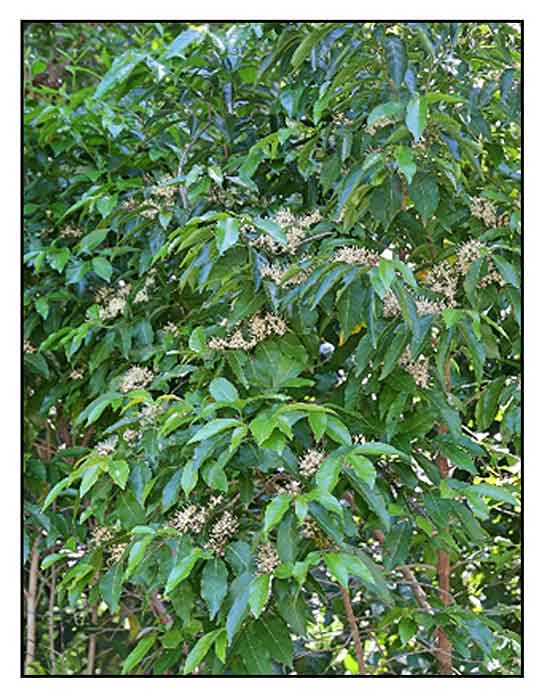 Gen info Gen info
- Aidia is a genus of flowering plants in the family Rubiaceae. It was described by Joao de Loureiro in 1790. It has a wide distribution area, occurring in tropical Africa, tropical and subtropical Asia and the western Pacific. (5)
-
Etymology: The genus name Aidia derives from Greek idios, meaning 'distinct' or 'separate'. The Greek prefix a- (a-) is the equivalent in English of 'un' or 'not', probably indicating that the genus Aidia is separated from the similar genus Randia. Species epithet racemosa derives from Latin racemosus, meaning 'full of clusters'.
(3)
Botany
Aidia racemosa is a tree to 25 m tall; branches somewhat flattened becoming subterete, glabrous. Petiole 5-6 mm, glabrous; leaf blade drying thinly leathery, lanceolate to elliptic-oblong, 7-12 × 2-4 cm, glabrous on both surfaces, base acute to cuneate, apex acute; secondary veins 4 or 5 pairs, in abaxial axils usually with foveolate and/or pilosulous domatia; stipules caducous, shortly united around stem, narrowly triangular, 3-5 mm, glabrous, apex acuminate. Inflorescences cymose, ca. 3 × 4-6 cm, glabrescent, with axes becoming monochasial distally; peduncle ca. 0.5 cm; bracts triangular, 1-1.5 mm, acute; pedicels 1-3 mm. Calyx glabrous; ovary portion ellipsoid, ca. 1 mm; limb ca. 1.5 mm, shortly dentate to denticulate; teeth 5. Corolla white, outside glabrous; tube ca. 4 mm; lobes 5, narrowly spatulate-oblong, 5-5.5 mm, adaxially strigillose, obtuse to rounded. Berry 4-8 mm in diam., glabrous. (Flora of China)
 Aidia racemosa is a woody or herbaceous shrub that can grow up to 6 m in height. Branches are somewhat flattened, becoming subterete, and are glabrous. Although the leaves at first sight appear to be opposite, many of the ‘pairs’ of leaves are missing one of the leaves. Leaves are glossy green above, paler beneath; the petioles are about 5 mm long; the leaf blades thinly leathery, lanceolate to oblong-elliptic, in length 7 – 12 cm, in width 2 – 4 cm; the base is acute to cuneate, the apex acute; the stipules are caducous, shortly united around the stem, narrowly triangular, up to 5 mm long, the apex acuminate. Inflorescences are cyme-like, with the cream-colored flowers strongly perfumed; the calyyx is up to 2 mm long, the lobes short; the corolla about 1 cm long, with the lobes about the same length as the tube, as are also the anthers. Fruits
are bright red darkening to purple, and less than 1 cm long, with the calyx tube persisting at the ends of the fruits. They are edible when fully ripe, rather tart. (3) Aidia racemosa is a woody or herbaceous shrub that can grow up to 6 m in height. Branches are somewhat flattened, becoming subterete, and are glabrous. Although the leaves at first sight appear to be opposite, many of the ‘pairs’ of leaves are missing one of the leaves. Leaves are glossy green above, paler beneath; the petioles are about 5 mm long; the leaf blades thinly leathery, lanceolate to oblong-elliptic, in length 7 – 12 cm, in width 2 – 4 cm; the base is acute to cuneate, the apex acute; the stipules are caducous, shortly united around the stem, narrowly triangular, up to 5 mm long, the apex acuminate. Inflorescences are cyme-like, with the cream-colored flowers strongly perfumed; the calyyx is up to 2 mm long, the lobes short; the corolla about 1 cm long, with the lobes about the same length as the tube, as are also the anthers. Fruits
are bright red darkening to purple, and less than 1 cm long, with the calyx tube persisting at the ends of the fruits. They are edible when fully ripe, rather tart. (3)
Distribution
- Native to the Philippines.
- On dry, forested slopes on the borders of grasslands, and in thickets at low altitudes in Mindoro, Culion, Busuanga, Palawan, and Balabac.
- Also native to Australia, Borneo, Caroline Is., Christmas Is., Gilbert Is., Hainan, Jawa, Lesser Sunda Is., Malaya, Maluku, Marianas, Marshal Is., Nauru, New Guinea, Nicobar Is., Northern Territory, Queensland, Samoa, Solomon Is., Sulawesi, Taiwan, Thailand, Tonga, Vanuatu, Vietnam, Wallis-Futuna Is. (2)
Properties
- Bark considered febrifuge.
- Studies have suggest antioxidant, anticancer properties.
Parts used
Leaves, roots.
 Uses Uses
Edibility
- Leaves prepared as tonic herbal tea.
Folkloric
- In the Philippines, used as a febrifuge, especially in ague.
-
In Malaysia a decoction of roots used for bowel complaints.
- Leaves and roots used to relieve body aches, painful muscles and tiredness; also to treat stomach pains.
- In Vanuatu, decoction of leaves used to bathe skin inflicted with scabies. (6)
Others
- Wood: Trunk of the tree is very hard; used for making tool handles and chopping boards, for house and bridge constructions, furniture, and doors.
- Charocoal: Yields good quality charcoal and fuelwood.
Studies
• Antioxidant / Anticancer: In a study of crude methanol, ethanol and aqueous extracts of leaves from six plants found in Brunei Darussalam for antioxidant and cytotoxic activities, Aidia racemosa high TPC (total phenolic content), high TFC (total flavonoid content) and DPPH radical scavenging activity. On cytotoxicity testing, A. racemosa showed anticancer property against A549 and CaSki cells. (4) Leaf extract showed good cytotoxic activity against renal cancer cell line 786-0. (6)
• Effect of Commercial Plant Hormones / Stem Cuttings: Study evaluated the effect of three commercial plant hormones (Seradix, Clonex, and 'A fruit plus') on the growth of Aidia racemosa stem cuttings. Clonex-treated stem cuttings showed slightly higher survival and rooting percentages than other treatments. There were no other effects on various growth parameters. Seradix and A-fruit-plus treatments produced higher number of new leaves while clonex produces larger leaves. Results suggest clonex to be the most suitable hormone for vegetative propagation of A. racemosa. (7)
Availability
Wild-crafted.
Herbal tea in the cybermarket.
|

![]()






